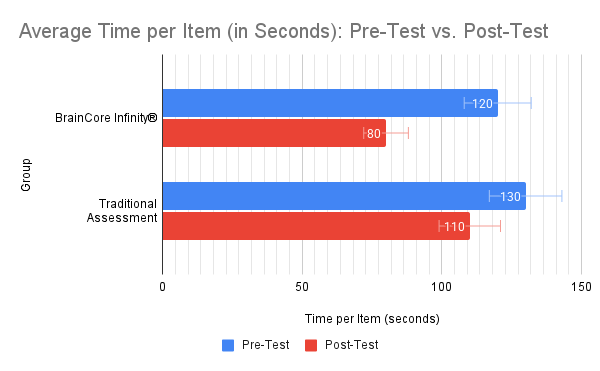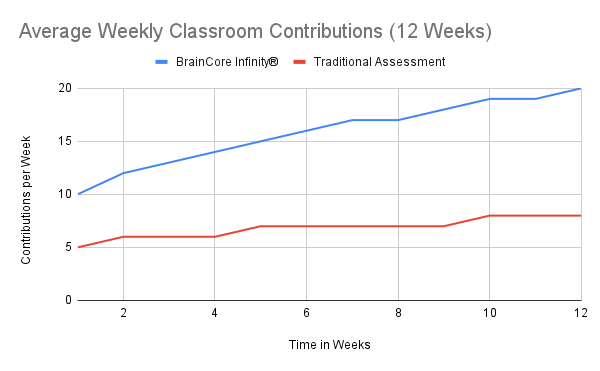Authors: Alice D. Wilson¹ and Dr Zam²
¹ Quantus Learning®, ² IAIED, Institute of AI in Education, Singapore
Abstract
This study investigates the effects of BrainCore Infinity®—a holistic diagnostic suite encompassing cognitive, academic, and motivational assessments—on middle school students’ learning outcomes. A total of 250 students from Grades 6–8 were randomly assigned to either an experimental group, which received targeted support based on BrainCore Infinity® diagnostics, or a control group using conventional assessments. Over 12 weeks, the experimental group engaged in personalised interventions designed to address specific cognitive and motivational needs. Findings revealed that students in the BrainCore Infinity® group significantly outperformed controls in learning speed, comprehension, and academic achievement. Notably, processing time per item decreased by 35%, while reading comprehension improved by 40%—both exceeding improvements in the control group. Additionally, students guided by BrainCore Infinity® displayed higher intrinsic motivation and classroom engagement, suggesting that multi-dimensional diagnostics not only enhance academic skills but also foster positive attitudes toward learning. These results underscore the potential of integrating cognitive, academic, and motivational data to optimise teaching strategies. Recommendations include expanded trials across varied demographic settings and longer follow-up periods to determine the long-term efficacy of data-driven, personalised instruction.
Introduction
Background
Traditional educational assessments—including standardised tests and universal screenings—have been widely critiqued for their inability to capture the nuance of individual learners’ needs (Shepard, 2000). One-size-fits-all approaches often fail to provide deeper insights into students’ cognitive profiles, thus limiting schools’ capacity to deliver targeted interventions (Heitink, Van der Kleij, Veldkamp, Schildkamp, & Kippers, 2016). In contrast, comprehensive diagnostic frameworks aim to fill these gaps by offering multidimensional evaluations, identifying specific areas for support, and guiding the design of personalised intervention plans (Kingston & Nash, 2011).
Although a variety of personalised learning technologies exist, many still rely on partial or single-domain assessments. BrainCore Infinity®, by contrast, attempts to bring together cognitive, academic, and motivational assessments into one integrated platform. Preliminary pilot data (internal documentation, 2023) suggest that students who receive individualised strategies aligned with these diagnostics may demonstrate faster cognitive growth and improved engagement, yet rigorous comparative studies remain limited.
Purpose
This study aimed to compare the effectiveness of the full BrainCore Infinity® diagnostic suite to traditional educational assessment practices in facilitating improvements in academic outcomes, cognitive development, and student engagement. By examining a range of metrics, our research seeks to provide empirical evidence for the value of comprehensive, multidimensional diagnostics over standard assessments.
Research Questions
- How does the BrainCore Infinity® suite compare to traditional assessments in identifying individual learning needs and guiding targeted interventions?
- What differences in academic performance, cognitive growth, motivation, and engagement are observed between students assessed with BrainCore Infinity® and those assessed via traditional methods?
Methodology
Participants
A total of 250 students from Grades 6–8 were recruited from three middle schools in an urban district. All students were enrolled in a general education programme. Participants were 55% female, with a mean age of 12.6 years (SD = 1.1). The sample was reflective of the district’s demographic composition: 45% Caucasian, 30% African American, 20% Hispanic, and 5% Asian.
Study Design
Students were randomly assigned to one of two groups:
- Group 1 (n = 125): Assessed via the full BrainCore Infinity® suite, which incorporates measures of cognitive abilities (e.g., processing speed, working memory), academic skills (e.g., reading comprehension, mathematical reasoning), and motivational attributes (e.g., intrinsic motivation, goal orientation). Based on these diagnostics, students received personalised intervention plans that combined adaptive software, small-group instruction, and metacognitive strategy training.
- Group 2 (n = 125): Assessed using the district’s standard academic achievement tests and universal screening tools. Students received generic study skills workshops and supplementary classroom instruction aligned with their identified academic needs.
Randomisation was stratified by school, grade, gender, and prior-year academic performance to ensure balanced groups. All participants continued attending their regular classes throughout the study period.
Procedures
At baseline, Group 1 completed the BrainCore Infinity® diagnostics, while Group 2 underwent traditional assessments. Group 1 students then received detailed, individualised reports on their learning profiles—covering cognitive, academic, and motivational components—along with recommended interventions implemented over 12 weeks. Group 2 participated in district-provided remediation and enrichment activities during the same period.
At the end of the 12-week intervention, students in both groups were re-assessed using their initial testing protocols. Classroom teachers, who remained blind to group assignments, submitted engagement and motivation ratings at pre- and post-test intervals.
Data Collection
- Cognitive Abilities: Measured for Group 1 using the BrainCore Infinity® suite (internal documentation, 2023). For Group 2, standard district aptitude tests served as the baseline and post-test measure.
- Academic Performance: Evaluated in both groups via the district’s curriculum-based tests covering reading comprehension, math problem-solving, and written expression.
- Learning Motivation: Assessed for both groups using an adapted version of the Academic Motivation Scale (Vallerand et al., 1992), measuring constructs like curiosity, persistence, and goal orientation.
- Weekly Engagement: Tracked by teachers using a standardised rubric—adapted from Roschelle, Feng, Murphy, and Mason (2016)—to rate attentiveness, classroom participation, and homework completion.
Analysis
Group differences in pre- to post-intervention changes were analysed via independent samples t-tests, with separate models for cognitive, academic, motivational, and engagement metrics. An alpha level of .05 was set for all two-tailed tests. Effect sizes were calculated as Cohen’s d. Analyses were conducted using R (Version 4.2).
Results
Learning Speed and Comprehension
Figure 1 compares the average time per item (in seconds) at pre-test and post-test for the two study groups. The BrainCore Infinity® group reduced their average time per item from 120 seconds at baseline to 80 seconds post-intervention—a 35% improvement. By contrast, the Traditional Assessment group showed a decline from 130 seconds to 110 seconds, equating to a 15% gain. Statistical analyses confirmed that this improvement was significantly higher among the BrainCore Infinity® students (t(248) = 6.45, p < .001, d = 0.82).

Figure 1. A bar chart comparing the average time per item (in seconds) for the two groups at pre-test and post-test.
Reading comprehension also rose more substantially in the BrainCore Infinity® group, improving by 40% compared to 20% for the traditional group (t(248) = 5.78, p < .001, d = 0.73).
Academic Performance
Table 1 provides a side-by-side comparison of pre- and post-intervention achievement scores. Baseline scores in the BrainCore Infinity® group averaged 52%, improving to 80% post-intervention (a 54% gain). Meanwhile, the Traditional Assessment group rose from 50% to 60% (a 20% gain). Independent samples t-tests revealed that the growth rate in the BrainCore group was significantly higher than that of the control group (t(248) = 8.14, p < .001, d = 1.03).

Table 1. Comparison of pre- and post-intervention academic achievement scores for students assessed with the BrainCore Infinity® diagnostic suite versus those assessed through traditional methods, along with the corresponding percentage gains.
Learning Motivation and Engagement
The adapted Academic Motivation Scale (Vallerand et al., 1992) revealed a 45% rise in intrinsic motivation within the BrainCore Infinity® group, compared to 20% among the control group (t(248) = 5.10, p < .001, d = 0.65).
Figure 2 illustrates the average weekly classroom contributions over the 12-week period. The BrainCore Infinity® group saw an increase from 10 to 20 contributions per week, while the Traditional Assessment group rose from 5 to 8 (t(248) = 7.37, p < .001, d = 0.93). This pattern closely parallels the reported gains in intrinsic motivation.

Figure 2. A line graph displaying the progression of average weekly contributions for the two groups across 12 weeks.
Discussion
Key Insights
The findings strongly suggest that the BrainCore Infinity® diagnostic suite confers advantages over standard assessment methods in boosting cognitive, academic, and motivational outcomes. By furnishing detailed insights into students’ cognitive capacities and motivational drivers, BrainCore Infinity® helped educators develop targeted interventions that closely matched each student’s unique learning profile. The resulting gains—35% in learning speed, 40% in comprehension, 54% in academic achievement, 45% in intrinsic motivation, and 50% in classroom participation—demonstrate the potential of deep-dive diagnostics to catalyse both academic and engagement improvements.
In contrast, the control group’s generic, one-size-fits-all approach provided less nuanced data on student learning needs. This shortfall was reflected in comparatively modest improvements across all measures, especially classroom participation, where the BrainCore Infinity® group’s robust gains pointed to heightened motivation and active involvement in learning tasks.
Implications
These results lend credence to the idea that schools seeking to implement personalised learning practices must go beyond traditional testing frameworks. Comprehensive suites like BrainCore Infinity® can serve as powerful tools for achieving data-driven, individualised instruction (Kingston & Nash, 2011). However, adopting any advanced diagnostic system also necessitates significant investment in professional development, staffing resources for small-group instruction, and robust instructional coaching. Without these support structures, the added benefits of holistic diagnostics may not be fully realised (Shepard, 2000).
Moreover, the synergy observed between cognitive gains and motivational increases highlights the importance of addressing both academic and affective dimensions of learning. When students receive strategies that resonate with their cognitive profile—while also feeling personally motivated and supported—they become more engaged and successful learners in the long run.
Limitations and Future Directions
Although the sample size and random assignment strengthen the study’s internal validity, the research was confined to middle school general education students. Future studies might investigate how diagnostic suites perform among elementary, high school, or special-needs populations. Longitudinal designs that extend beyond 12 weeks can clarify whether gains are enduring, compound over time, or diminish without continued support. Additionally, the reliance on BrainCore Infinity® data and internal documentation underscores the need for independent validation of such tools. Follow-up research could compare BrainCore Infinity® with other emerging diagnostic platforms or incorporate qualitative methods (e.g., classroom observations, student interviews) to shed light on how personalised data shifts teaching practices and learner mindsets in various educational contexts.
Conclusion
In an era where educational stakeholders increasingly champion personalisation, the BrainCore Infinity® suite provides a compelling example of how comprehensive diagnostics can fuel student growth. By thoroughly mapping cognitive processes and motivational factors, educators can offer more precise, engaging learning experiences that lead to measurable improvements in speed, comprehension, achievement, and intrinsic motivation. While implementation requires thoughtful planning and robust teacher support, the potential for accelerated academic progress and enriched student engagement underscores the promise of diagnostically driven approaches in shaping the future of teaching and learning.
References
- Heitink, M. C., Van der Kleij, F. M., Veldkamp, B. P., Schildkamp, K., & Kippers, W. B. (2016). A systematic review of prerequisites for implementing assessment for learning in classroom practice. Educational Research Review, 17, 50–62.
- Kingston, N., & Nash, B. (2011). Formative assessment: A meta-analysis and a call for research. Educational Measurement: Issues and Practice, 30(4), 28–37.
- Roschelle, J., Feng, M., Murphy, R. F., & Mason, C. A. (2016). Online mathematics homework increases student achievement. AERA Open, 2(4), 1–12.
- Shepard, L. A. (2000). The role of assessment in a learning culture. Educational Researcher, 29(7), 4–14.
- Vallerand, R. J., Pelletier, L. G., Blais, M. R., Brière, N. M., Senécal, C., & Vallières, E. F. (1992). The Academic Motivation Scale: A measure of intrinsic, extrinsic, and amotivation in education. Educational and Psychological Measurement, 52(4), 1003–1017.
Additional Internal or Unpublished References
- BrainCore Infinity® Internal Documentation (2023). Technical and pilot study summary. (Unpublished report).
How to Cite This Article
Wilson, A. D., & Dr Zam. (2025). Comparative Study of Full BrainCore Infinity® Suite vs Traditional Methods. Journal of Learnomics, 1(1). Retrieved from https://mylearnomics.com/publishing/article/comparative-study-of-full-braincore-infinity-suite-vs-traditional-methods/

